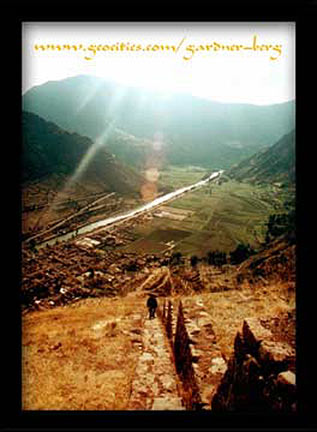
Pisac, PERU
| Translate: EspaŮol - FranÁais - Deutsch - Italiano - PortuguÍs - Japanese - Korean - Chinese |

Pisac, PERU
| Translate: EspaŮol - FranÁais - Deutsch - Italiano - PortuguÍs - Japanese - Korean - Chinese |

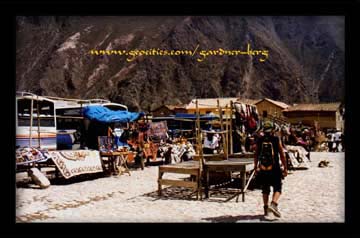 NOVEMBER 1, 2000 -- (8am) After a month and a half in La Paz, we take a 12 hour bus back to Peru and re-enter on route to Cuzco via Puno; a non-stop ride.
NOVEMBER 1, 2000 -- (8am) After a month and a half in La Paz, we take a 12 hour bus back to Peru and re-enter on route to Cuzco via Puno; a non-stop ride.
Arrival at Cuzco around the long distance bus offices and train station by the waterfall monument. We decide to stay at a hotel across the road from where the bus parks for the night. Even though it's facilities are basic and cheap, the owners were nice to us making our stay comfortable and a pleasure. Communication, as usual, is limited. But it never really matters, does it?
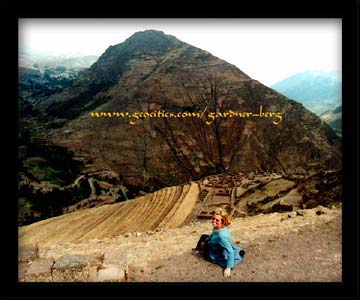
Cuzco (or 'Qosqo' in Quechua) was once the capital of the Inca Empire; an empire whose territory stretched from Ecuador to the northern half to Chile running the area along the Andes and Pacific coast.
When the Conquistador, Pizarro and his men marched into Cuzco on November 15, 1533 they found a city of rectangular single-storey houses topped with thatched roofs. A clean place in clear mountain air. It's narrow streets had channels of water flowing along them, and 2 small streams in the city centre were held in stone-lined culverts. Spanish chroniclers also described its public buildings - palaces of each of the dead Inca emperors and sun temples and other deities - all grouped near a vast plaza.
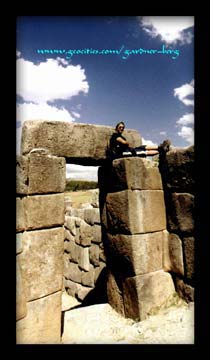 Although it has become apparent that the powerful families from which the Incas descended were originally established around Cuzco, in the heart of the Cordillera, it is extremely difficult to retrace precisely the chronological stages that led from the Cuzco confederation to the Inca empire. According to accounts gathered by European chroniclers, it was the Inca (Emperor)- Pachacuti who, in the 15th century, built the formidable empire that was discovered by the dazzled Spaniards. The people of Cuzco referred to their empire as the 'Land of the 4 Quarters' or 'Tahuantinsuyu', a name that was arranged around Cuzco, the 'navel', in 4 great sectors orientated to the cardinal points. To the north stretched 1. Chinchaysuyu; to the south 2. Qollasuyu, where the Lupaqa lords of Lake Titicaca lived; 3. Cuntisuyu extended westward to the coast; and finally 4. Antisuyu opened on to the Amazonian region, which the Incas never really managed to subjugate despite attempts.
Although it has become apparent that the powerful families from which the Incas descended were originally established around Cuzco, in the heart of the Cordillera, it is extremely difficult to retrace precisely the chronological stages that led from the Cuzco confederation to the Inca empire. According to accounts gathered by European chroniclers, it was the Inca (Emperor)- Pachacuti who, in the 15th century, built the formidable empire that was discovered by the dazzled Spaniards. The people of Cuzco referred to their empire as the 'Land of the 4 Quarters' or 'Tahuantinsuyu', a name that was arranged around Cuzco, the 'navel', in 4 great sectors orientated to the cardinal points. To the north stretched 1. Chinchaysuyu; to the south 2. Qollasuyu, where the Lupaqa lords of Lake Titicaca lived; 3. Cuntisuyu extended westward to the coast; and finally 4. Antisuyu opened on to the Amazonian region, which the Incas never really managed to subjugate despite attempts.
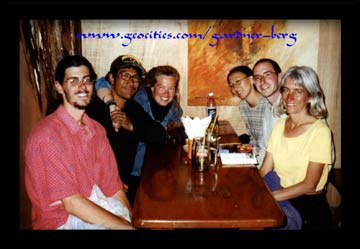 NOVEMBER 4, 2000 -- We met with 2 fellow travellers from San Francisco, USA; a couple we'd met previously in Vilcabamba, Ecuador almost a year ago. It sure was good to see some familiar faces for a change just to vent and laugh about the ups and downs of long term travel in Latin America.
NOVEMBER 4, 2000 -- We met with 2 fellow travellers from San Francisco, USA; a couple we'd met previously in Vilcabamba, Ecuador almost a year ago. It sure was good to see some familiar faces for a change just to vent and laugh about the ups and downs of long term travel in Latin America.
NOVEMBER 6, 2000 -- The Sacred Valley of the Incas follows the middle section of the Urubamba, a few kms from Cuzco. At Pisac, the stepped terraces traversed the slopes for several hundred metres and produced the finest maize in the empire, especially destined for the lords rituals. The whole valley belonged to the Inca and the royal lineages.
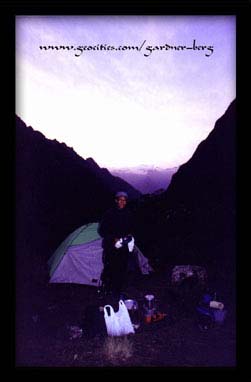 The 4 of us head to Pisac ruins on the 9.30am bus from Cuzco. This old stone fortress (32 kms N) outpost contains within its masonry groups of temples and solar dials to measure and record solstices. The vast agricultural terraces surrounding the ruin site are still functional and in use. Also seen were adobe work containing niches, probably used for displaying ornaments of worship. A very impressive place.
The 4 of us head to Pisac ruins on the 9.30am bus from Cuzco. This old stone fortress (32 kms N) outpost contains within its masonry groups of temples and solar dials to measure and record solstices. The vast agricultural terraces surrounding the ruin site are still functional and in use. Also seen were adobe work containing niches, probably used for displaying ornaments of worship. A very impressive place.
The next morning a bus takes us up to Tambo Machay, just a few kms out of town on the road to Pisac (13.5 km). A small site displaying Incan masonry guiding tapped spring water into canals and baths. Across the road is the fortress-like structure - Puca Pucara. Walking along the road towards Cuzco we pass Q'enqo - with its huge solid granite with carved steps and interior chamber possibly reserved for high rank or ceremonial worship - impressive stonework - perhaps an altar. At the top, carved stone protrusions for astronomical or calendrical observations. And lastly, Sacsayhuaman. Probably the most famous and outstanding example of Incan construction stonework (so-called 'Cyclopean' masonry) - its huge irregular stones fitted together with minute precision.

NOVEMBER 8, 2000 -- Not far east of Cuzco are the ruins of Tipon; a temple complex supported by terraces, irrigation systems and baths. A hot day today had us taking advantage of the flowing cool spring waters for almost 2 hours. Quiet, beautiful, tranquil, nice...
The next day, it's off to Ollantaytambo 65kms west along the Urubamba River from Pisac. Some say it was a fortress; others say a temple. Whatever it was (maybe both), Ollantaytambo was built perhaps for several functions: besides watching over the Urubamba Valley and keeping a lookout for the sporadic incursions by forest tribes which the Inca always feared, it was also an agricultural centre, like Pisac. Judging by the quality of the buildings, water channels and sanctuaries, it may have served as residence for the Inca and/or his family. The style of its stonework, according to archaeologists, suggests that Ollantaytambo was built in the 2nd half othe 15th century.
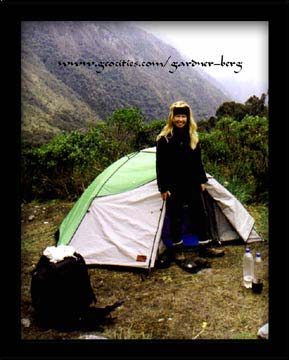 NOVEMBER 12, 2000 -- It's early morning, and fully packed we head to the San Pedro Station to catch a train to the entry point (Km 88 - Qorihuayrachina at 2299 m.a.s.l.) of the Inca Trail to Machu Picchu. We get off to a slow start though. Getting there with the mid-morning sun beating down and already cursing our heavy packs, we huffed and puffed up to the first campsite at Huayabamba village. It was a little difficult to relax here; constantly being bombarded with offers from villagers to ease the weight off our aching backs. But that's the whole idea for us to do the trail independently; just to get some idea and appreciation of human ability to cope in the unforgiving Andean environment. It never ceases to amaze us as we witness the incredible strength and quickness of the Andean porters. These indigenous individuals are short, stocky, beardless and broad-shouldered with a stoicism similar to that of the North American Indian.
NOVEMBER 12, 2000 -- It's early morning, and fully packed we head to the San Pedro Station to catch a train to the entry point (Km 88 - Qorihuayrachina at 2299 m.a.s.l.) of the Inca Trail to Machu Picchu. We get off to a slow start though. Getting there with the mid-morning sun beating down and already cursing our heavy packs, we huffed and puffed up to the first campsite at Huayabamba village. It was a little difficult to relax here; constantly being bombarded with offers from villagers to ease the weight off our aching backs. But that's the whole idea for us to do the trail independently; just to get some idea and appreciation of human ability to cope in the unforgiving Andean environment. It never ceases to amaze us as we witness the incredible strength and quickness of the Andean porters. These indigenous individuals are short, stocky, beardless and broad-shouldered with a stoicism similar to that of the North American Indian.
 During the 1920's a Peruvian physician, Dr. Carlos Monge conducted studies on dwellers of the high plateau regions of Peru and Bolivia. He had held that thousands of years of adaptation to the hostile climate made the Andean a kind of 'superhuman', one able to withstand the rigors of oxygen-poor air, temperature extremes, and strong solar radiation at high altitudes. Their chests were deeper, heart and spleen larger, their bone marrows manufacturing far more red corpuscles than lowlanders. Their food consists chiefly of beans, dried peas, parched corn, dried potatoes, along with the constant chewing of coca leaves.
During the 1920's a Peruvian physician, Dr. Carlos Monge conducted studies on dwellers of the high plateau regions of Peru and Bolivia. He had held that thousands of years of adaptation to the hostile climate made the Andean a kind of 'superhuman', one able to withstand the rigors of oxygen-poor air, temperature extremes, and strong solar radiation at high altitudes. Their chests were deeper, heart and spleen larger, their bone marrows manufacturing far more red corpuscles than lowlanders. Their food consists chiefly of beans, dried peas, parched corn, dried potatoes, along with the constant chewing of coca leaves.
Dr. Gustavo Zubieta of the High Altitude Pathology Clinic in Bolivia suggested in an article in 1987 that being born in the Andes or being of Indian parentage does not provide much genetic adaptation to hypoxia and its ills. He mentions that all highlanders, including Indians, forfeit their acclimatization if they stay long enough at sea level.
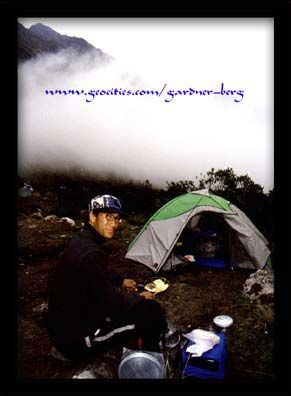
The next morning we quickly pack our gear and head west following the Llulluchayoc River passing through a cloud forest. A long uphill walk but the campsite at Llulluchapampa was a good one with great views. Our first real quiet night we've had in a long time.
NOVEMBER 14, 2000 -- Early start for the long, steep climb up the almost 4200 m.a.s.l. to Warmiwanusq'a (Dead Woman) Pass. During the 2 and a half hour ascent, the trail gradually bottlenecks toward the top. Travellers from all over the world catch up with us. It was a wonderful feeling reaching this high point. Looking down below we could see the Pacai Mayu River where our next campstop (Runkuraqay) will be. The afternoon turns cloudy and grey, prompting us to look ahead at the possibility of rain.
NOVEMBER 15, 2000 -- Another climb to the 2nd Pass then onward to Sayacmarca ruins. A tough day's hike for us; rain and mist throughout day and the disappointment that awaited us at the campsite near the ruins of Sayacmarca by a nice river. We were told that the site was reserved only for the group tours. Unfair as it was, we grudgingly walked the extra few kms passing Conchamarca on the way to an area of bog covered by thick mist, where all the other independent hikers were camping. No streams or rivers anywhere, only a single water hose.
NOVEMBER 16, 2000 -- It rained most of the night and continued this morning. Despite the dampness, the trail's cloud forest surroundings were hauntingly picturesque - along with the mists that hanging above the Urubamba Valley below us. Our stop for tonight would be on the edge of a ridge above the Phuyupatamarca ruins; there is a spring at the ruins, making it the sole water supply there. Breathtaking views of the valley late afternoon and the sounds of an Andean flute, played by one of the porters of a tour group camping above us, echoes across the highlands at dusk. We're getting closer - one could hear the humming of the hydroelectric plant and passing trains far below near the Urubamba River.
NOVEMBER 17, 2000 -- More rain this morning. We leave a little earlier this time and make our way to our final stop before Machu Picchu - the village of Winay Waina. On the way down, we passed through a partially restored terraced set of ruins (Intipata) overlooking the village below - very impressive construction. We did have mixed feelings approaching Winay Waina - the satellite dishes, the tall pylons carrying electrical cables from the dam. But a relief for our tired bones, nonetheless. Rather cramped for tent space here; it was an interesting experience but happy with ourselves for deciding to hike the trail outside of peak season.
Photos and Text Copyright © 1999-2001 Gardner-Berg. All rights reserved.
Sources of Further Reading-
Bingham, Hiram. "The Lost City of the Incas: The Story of Macchu Pichu and its Builders", 1951.
Cameron, Ian. The Kingdom of the Sun God: A History of the Andes and its People, 1990.
Garcilaso de la Vega, Inca. "The Royal Commentaries of the Incas and General History of Peru" 1869, 1871 and (original 1609).
Kendall, Ann. "The Everyday Life of the Inca" 1989.
Mosley, Michael E. "The Incas and their Ancestors: The Archaelogy of Peru" 1992.
Rostworowski De Diez Canseco, Maria. "History of the Inca Realm" 1998

